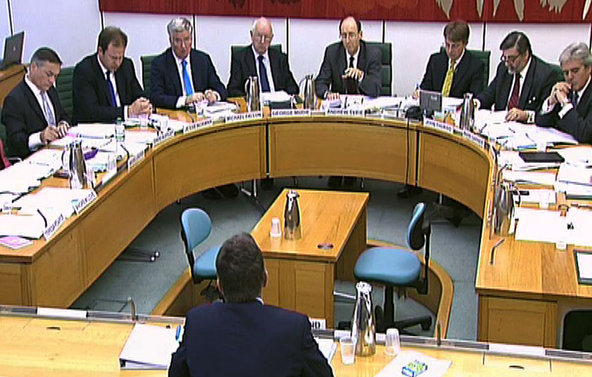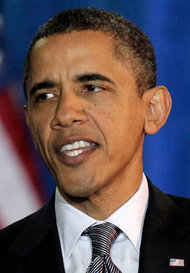 Agence France-Presse — Getty ImagesFormer Barclays chief Bob Diamond testified at the British Treasury Select Committee on Wednesday.
Agence France-Presse — Getty ImagesFormer Barclays chief Bob Diamond testified at the British Treasury Select Committee on Wednesday.
6:11 p.m. | Updated
LONDON — Robert E. Diamond Jr., the former chief executive of Barclays, told a British parliamentary committee on Wednesday that the manipulation of global interest rate benchmarks involving 14 traders at the bank had made him “physically sick.”
But the American-born banker, who resigned on Tuesday, also placed some of the blame for the rate manipulation scandal on regulators.
He said that the bank had raised concerns multiple times with American and British authorities about discrepancies over how Libor — the London interbank offered rate, a measure of how much banks charge each other for loans — was set. The bank was not told to stop the practice, according to Barclays’ documents submitted to the British Parliament.
“A number of banks were posting rates that were significantly below ours that we didn’t think were correct,” Mr. Diamond told the committee.
“I can’t sit here and say no one in the industry didn’t know about the problems with Libor,” he said. “There was an issue out there and it should have been dealt with more broadly.”
Mr. Diamond also sought to deflect attention from the bank’s role in the authorities’ continuing investigation, pointing out that other major global financial institutions also had been implicated. United States and British regulators, who announced a $450 million settlement with Barclays last week, are currently investigating the actions of more than 10 large financial institutions, including JPMorgan Chase, UBS and Citigroup.
The former chief of Barclays, who said he had been notified about the fines and civil penalties just a few days before the settlement was announced, said that the bank had been singled out because it was the first to settle.
The agreement with regulators showed that Barclays traders had altered Libor for their own benefit from 2005 to 2009. Senior executives also told employees to suppress the bank’s rate submissions during the three years through 2009, in response to the financial crisis that was pushing borrowing costs for most global financial institutions to record highs.
 ReutersMr. Diamond placed some of the blame for the rate manipulation scandal on regulators.
ReutersMr. Diamond placed some of the blame for the rate manipulation scandal on regulators.
The committees’ members, some of whom have worked in the financial services industry, including at Barclays, focused on the role of Mr. Diamond, who previously led the firm’s investment banking unit.
The 60-year-old executive, who initially appeared nervous giving his testimony, but gradually became more comfortable during the nearly three hours of questioning, batted away questions of his being solely to blame for the scandal.
“I don’t feel personal culpability. What I do feel is a strong sense of responsibility,” Mr. Diamond said, adding he had made the decision to resign when support from regulators and shareholders for his position at the bank began to wane.
He also implicated the Bank of England, the country’s central bank, and leading British politicians.
During his testimony, Mr. Diamond described a phone call he received at the end of October 2008 from Paul Tucker, a high-ranking official at the Bank of England. According to Mr. Diamond, Mr. Tucker expressed concerns from senior politicians that Barclays had been submitting rates consistently higher than rivals, a sign of relatively poor health.
Mr. Diamond then e-mailed Jerry del Missier, a top deputy, about the conversation, saying that Mr. Tucker had stated that it “did not always need to be the case that we appeared as high as we have recently,” according to documents released by the bank.
Mr. del Missier, who also resigned on Tuesday, subsequently directed employees to keep the submissions lower, or at least in line with rivals. His actions, some regulators say, were owed to a “miscommunication,” rather than instructions from Mr. Tucker.
Mr. Diamond reiterated that he had not told senior executives to suppress the bank’s Libor submissions. He said he had only been told last month about the activity, which occurred amid the financial crisis.
“I was unaware that Jerry had the impression that Tucker’s phone call was taken as an instruction,” he said.
Mr. Tucker, who is the front-runner to take over as governor of the Bank of England, on Wednesday made a request to testify to the committee about his role in the Barclays scandal.
Mr. Diamond is the first person implicated in the rate manipulation scandal to give evidence to the British parliamentary committee. The outgoing chairman of Barclays, Marcus Agius, and high-ranking officials from the Financial Services Authority, the country’s securities regulator, and the Bank of England also are expected to testify.
In addition, the British prime minister, David Cameron, has announced a wide-ranging inquiry into the British banking sector, and expects the results to be published by the end of the year.
During his testimony, Mr. Diamond reserved his most angry words for the Barclays’ traders who had manipulated rates to benefit their own trading positions.
Regulatory filings show Barclays officials shared information between the firm’s treasury department, which help set Libor, and trading units, which buy and sell financial products on a daily basis. Firms are expected to maintain so-called Chinese walls between the divisions, to avoid confidential information being used in pursuit of a profit.
But e-mails among Barclays employees that were released by regulators showed that when a trader wanted the treasury department to change a rate, an employee responded: “For you, anything,” Another quipped: “Done … for you big boy.”
Some of the individuals based in New York and London could still potentially face civil and criminal prosecutions.
“I am sorry, angry and disappointed,” Mr. Diamond told the parliamentary committee on Wednesday, his voice becoming increasingly emotional. “There’s no excuse for the traders’ actions. This is wrong, and I’m not happy about it.”
The members of Parliament also asked Mr. Diamond whether he would give up any bonuses or payments as part of his resignation package. The former Barclays chief replied that any changes would be a question for the bank’s board.
Mr. Diamond was awarded £6.3 million ($10.3 million) in pay and perks for last year, and British politicians have warned that any so-called golden parachute for leaving his post would be unacceptable.
“It would be completely wrong if people leaving under these circumstances were given some vast payoff,” Mr. Cameron, the prime minister, told Parliament on Wednesday. “It would be completely inexplicable to the public. I hope that won’t happen.”
Article source: http://dealbook.nytimes.com/2012/07/04/diamond-defends-barclays-response-to-interest-rate-scandal/?partner=rss&emc=rss

